Non-Traditional Plants for Your Garden Pond
By Albert V. Short, Fairfax Master Gardener Intern
The usual aquatic plant palette for a natural garden pond consists of water lilies, marginals (bog plants) and floaters or oxygenating plants. They work well under the proper conditions, but don’t be confined to these traditional plant choices. Try something new. Many of the perennial and annual plants you have in your garden will do well in an aquatic environment, and they will provide variety, color and texture to the pondscape.
When you consider using a terrestrial plant in an aquatic situation, first consider where it will do well in the landscape. If it is a sun lover, it will need those same conditions in a garden pond. Look at your garden pond to determine what will work in providing a sun-to-shade balance.
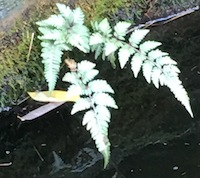 With moisture and deep shade, moss and ferns will naturally develop. This fern emerged on the pond edge from spores produced by a “mother” plant over 30 feet away. With moisture and deep shade, moss and ferns will naturally develop. This fern emerged on the pond edge from spores produced by a “mother” plant over 30 feet away. |
 Most groundcovers will root on the pond edge and will spread by runners. For example, bugleweed (Ajuga) is decorative and helps to “soften” the edge design. Japanese pachysandra (Pachysandra terminalis) will also do well. Most groundcovers will root on the pond edge and will spread by runners. For example, bugleweed (Ajuga) is decorative and helps to “soften” the edge design. Japanese pachysandra (Pachysandra terminalis) will also do well. |
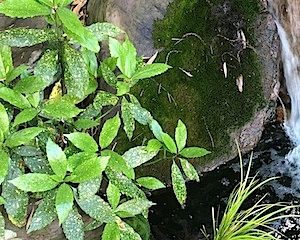 My pond has deep shade, especially in the vicinity of the waterfall, and the traditional water lilies and marginals do not do well. An Aucuba japonica ‘Gold Dust’ stuck in the rocks in the waterfall (with no pot) has been prospering for a few years, and it stays green all winter. In winter, the Aucuba gets iced up from the waterfall splash and loses a few leaves, but it comes back every spring. My pond has deep shade, especially in the vicinity of the waterfall, and the traditional water lilies and marginals do not do well. An Aucuba japonica ‘Gold Dust’ stuck in the rocks in the waterfall (with no pot) has been prospering for a few years, and it stays green all winter. In winter, the Aucuba gets iced up from the waterfall splash and loses a few leaves, but it comes back every spring. |
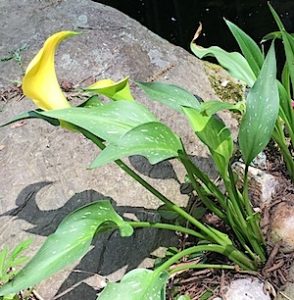 Calla lily (Zantedeschia aethiopica) adds a splash of color to the pond edge. In this photo, the bottom of the small container has been removed, and the plant pot is simply jammed between two large stones. They are not winter hardy. Calla lily (Zantedeschia aethiopica) adds a splash of color to the pond edge. In this photo, the bottom of the small container has been removed, and the plant pot is simply jammed between two large stones. They are not winter hardy. |
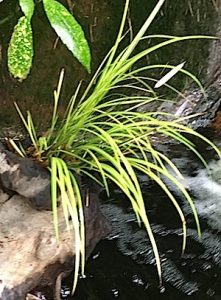 Sweet flag (Acorus gramineus) ‘Ogon’ is a traditional marginal plant, but it does well in partial shade. I planted it in the hollow end of a stump. It only gets water from waterfall splash, and it will survive the winter as it is hardy to minus 10 F. Sweet flag (Acorus gramineus) ‘Ogon’ is a traditional marginal plant, but it does well in partial shade. I planted it in the hollow end of a stump. It only gets water from waterfall splash, and it will survive the winter as it is hardy to minus 10 F. |
Impatiens wallerana do not tolerate full sun, and they droop easily. Embed them in a pond edge, and you will have no droop and plenty of color. Coleus (Solenostemon) also thrive in this environment.
Hints on using non-traditional water garden plants:
- Keep the crown of the plant above the water line, and let the roots go down for a drink.
- If you use a container, use gravel or clay and not potting soil or peat as it will float. Also, cut out the bottom of any container so the roots can grow down into the water. The plant gets its nutrition from the nitrogen in the water, not the soil in the pot.
The advantages of using nontraditional plants in the aquatic environment include:
- They add variety, color and texture when other traditional water garden plants will not do well due to lack of sun.
- You don’t have to water your plants that are rooted in the water…low labor factor.
- Non-traditional plants used in an aquatic environment seem to be less prone to disease. This may be because they are never starved of water.
These plants (as well as the traditional aquatics) consume nitrogen from the water that otherwise would feed algae. They help keep the pond water clear, vital and balanced.
Don’t abandon the traditional water garden aquatic plants; however, don’t be restricted by this standard plant palette. See what works, and experimentation can result in some interesting additions to your garden pond.
Resources
Water Garden Plants, Virginia Cooperative Extension
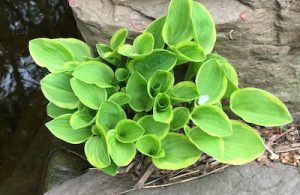 There are some terrestrial plants that I have used successfully in my garden pond, which is in shade most of the day. I have not found a Hosta variety that does not do well in water. I have left some rooted in driftwood or gravel all winter, and they have survived the winter freeze. Always consider the mature size of the plant, as with Hostas and others. Some may grow too large in proportion to the pond size and look out of place.
There are some terrestrial plants that I have used successfully in my garden pond, which is in shade most of the day. I have not found a Hosta variety that does not do well in water. I have left some rooted in driftwood or gravel all winter, and they have survived the winter freeze. Always consider the mature size of the plant, as with Hostas and others. Some may grow too large in proportion to the pond size and look out of place.
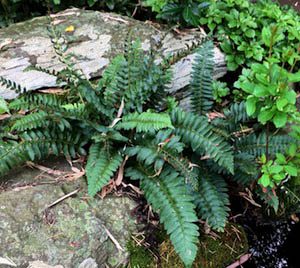 Most ferns (Polypodiopsida) like shade and water. Place the crown up and out of the water so the roots can get down to the water, and they will thrive. Some varieties, such as Polystichum acrostichoides ‘Christmas Fern,’ stay green all winter, and even the dead foliage gives a natural look to the pond edge.
Most ferns (Polypodiopsida) like shade and water. Place the crown up and out of the water so the roots can get down to the water, and they will thrive. Some varieties, such as Polystichum acrostichoides ‘Christmas Fern,’ stay green all winter, and even the dead foliage gives a natural look to the pond edge.